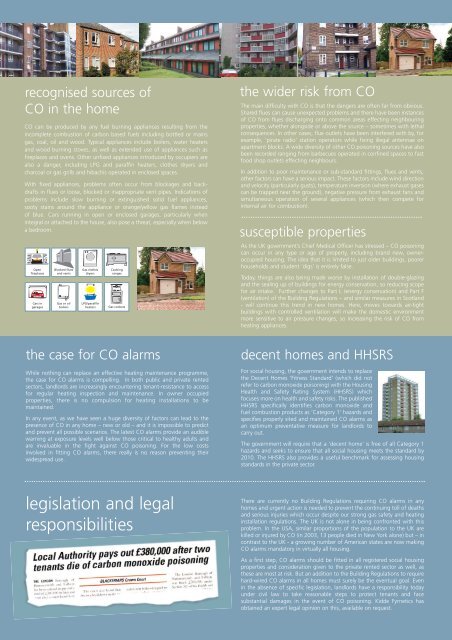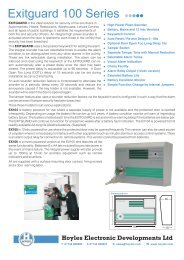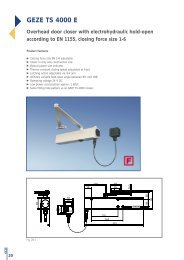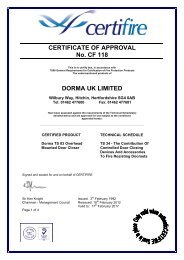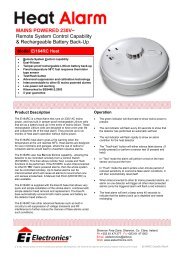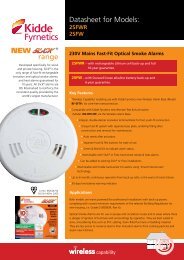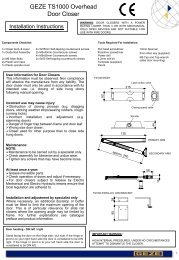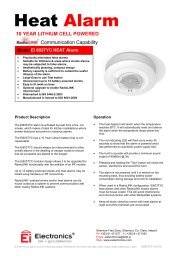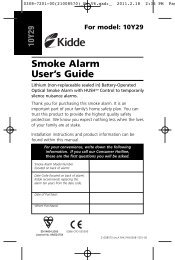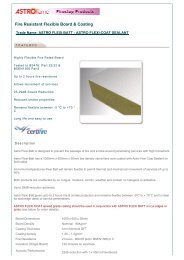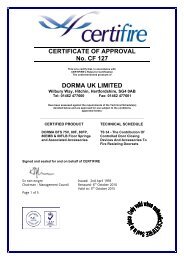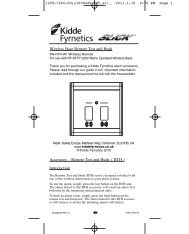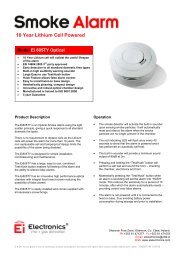Hard Wired Carbon Monoxide Alarms For Homes - Safelincs
Hard Wired Carbon Monoxide Alarms For Homes - Safelincs
Hard Wired Carbon Monoxide Alarms For Homes - Safelincs
You also want an ePaper? Increase the reach of your titles
YUMPU automatically turns print PDFs into web optimized ePapers that Google loves.
ecognised sources ofCO in the homeCO can be produced by any fuel burning appliances resulting from theincomplete combustion of carbon based fuels including bottled or mainsgas, coal, oil and wood. Typical appliances include boilers, water heatersand wood burning stoves, as well as extended use of appliances such asfireplaces and ovens. Other unfixed appliances introduced by occupiers arealso a danger, including LPG and paraffin heaters, clothes dryers andcharcoal or gas grills and hibachis operated in enclosed spaces.With fixed appliances, problems often occur from blockages and backdraftsin flues or loose, blocked or inappropriate vent pipes. Indications ofproblems include slow burning or extinguished solid fuel appliances,sooty stains around the appliance or orange/yellow gas flames insteadof blue. Cars running in open or enclosed garages, particularly whenintegral or attached to the house, also pose a threat, especially when belowa bedroom.OpenfireplacesCars ingaragesBlocked fluesand ventsGas or oilboilersGas clothesdryersLPG/paraffinheatersCookingrangesGas cookersthe wider risk from COThe main difficulty with CO is that the dangers are often far from obvious.Shared flues can cause unexpected problems and there have been instancesof CO from flues discharging onto common areas effecting neighbouringproperties, whether alongside or above the source – sometimes with lethalconsequences. In other cases, flue outlets have been interfered with by, forexample, ‘pirate radio’ station operators while fixing illegal antennae onapartment blocks. A wide diversity of other CO poisoning sources have alsobeen recorded ranging from barbecues operated in confined spaces to fastfood shop outlets effecting neighbours.In addition to poor maintenance or sub-standard fittings, flues and vents,other factors can have a serious impact. These factors include wind directionand velocity (particularly gusts), temperature inversion (where exhaust gasescan be trapped near the ground), negative pressure from exhaust fans andsimultaneous operation of several appliances (which then compete forinternal air for combustion).susceptible propertiesAs the UK government’s Chief Medical Officer has stressed – CO poisoningcan occur in any type or age of property, including brand new, owneroccupiedhousing. The idea that it is limited to just older buildings, poorerhouseholds and student ‘digs’ is entirely false.Today, things are also being made worse by installation of double-glazingand the sealing up of buildings for energy conservation, so reducing scopefor air intake. Further changes to Part L (energy conservation) and Part F(ventilation) of the Building Regulations – and similar measures in Scotland- will continue this trend in new homes. Here, moves towards air-tightbuildings with controlled ventilation will make the domestic environmentmore sensitive to air pressure changes, so increasing the risk of CO fromheating appliances.the case for CO alarmsWhile nothing can replace an effective heating maintenance programme,the case for CO alarms is compelling. In both public and private rentedsectors, landlords are increasingly encountering tenant-resistance to accessfor regular heating inspection and maintenance. In owner occupiedproperties, there is no compulsion for heating installations to bemaintained.In any event, as we have seen a huge diversity of factors can lead to thepresence of CO in any home – new or old – and it is impossible to predictand prevent all possible scenarios. The latest CO alarms provide an audiblewarning at exposure levels well below those critical to healthy adults andare invaluable in the fight against CO poisoning. <strong>For</strong> the low costsinvolved in fitting CO alarms, there really is no reason preventing theirwidespread use.decent homes and HHSRS<strong>For</strong> social housing, the government intends to replacethe Decent <strong>Homes</strong> ‘Fitness Standard’ (which did notrefer to carbon monoxide poisoning) with the HousingHealth and Safety Rating System (HHSRS) whichfocuses more on health and safety risks. The publishedHHSRS specifically identifies carbon monoxide andfuel combustion products as ‘Category 1’ hazards andspecifies properly sited and maintained CO alarms asan optimum preventative measure for landlords tocarry out.The government will require that a ‘decent home’ is free of all Category 1hazards and seeks to ensure that all social housing meets the standard by2010. The HHSRS also provides a useful benchmark for assessing housingstandards in the private sector.legislation and legalresponsibilitiesThere are currently no Building Regulations requiring CO alarms in anyhomes and urgent action is needed to prevent the continuing toll of deathsand serious injuries which occur despite our strong gas safety and heatinginstallation regulations. The UK is not alone in being confronted with thisproblem. In the USA, similar proportions of the population to the UK arekilled or injured by CO (in 2003, 13 people died in New York alone) but – incontrast to the UK - a growing number of American states are now makingCO alarms mandatory in virtually all housing.As a first step, CO alarms should be fitted in all registered social housingproperties and consideration given to the private rented sector as well, asthese are most at risk. But an addition to the Building Regulations to requirehard-wired CO alarms in all homes must surely be the eventual goal. Evenin the absence of specific legislation, landlords have a responsibility todayunder civil law to take reasonable steps to protect tenants and facesubstantial damages in the event of CO poisoning. Kidde Fyrnetics hasobtained an expert legal opinion on this, available on request.


